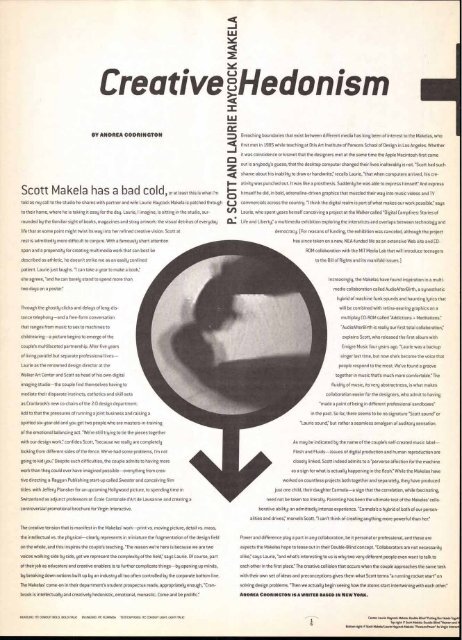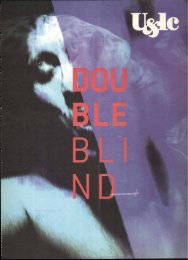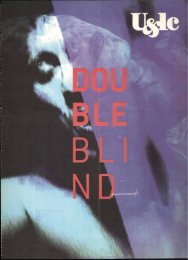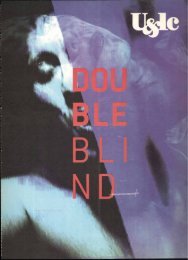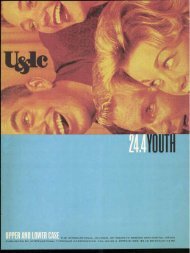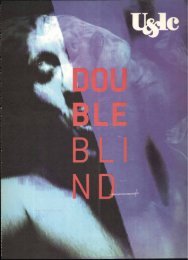You also want an ePaper? Increase the reach of your titles
YUMPU automatically turns print PDFs into web optimized ePapers that Google loves.
Creative,5Hedonism<br />
BY ANDREA CODROICTON<br />
S cott Makela has a bad cold, or at least this is what I'm<br />
told as my call to the studio he shares with partner and wife Laurie Haycock Makela is patched through<br />
to their home, where he is taking it easy for the day. Laurie, I imagine, is sitting in the studio, sur-<br />
rounded by the familiar sight of books, magazines and stray artwork: the visual detritus of everyday<br />
life that at some point might twist its way into her refined creative vision. Scott at<br />
rest is admittedly more difficult to conjure. With a famously short attention<br />
span and a propensity for creating multimedia work that can best be<br />
described as athletic, he doesn't strike me as an easily confined<br />
patient. Laurie just laughs. "I can take a year to make a book'<br />
she agrees, and he can barely stand to spend more than<br />
two days on a poster!'<br />
Through the ghostly clicks and delays of long-dis-<br />
tance telephony—and a free-form conversation<br />
that ranges from music to sex to machines to<br />
childrearing—a picture begins to emerge of the<br />
couple's multifaceted partnership. After five years<br />
of living parallel but separate professional lives—<br />
Laurie as the renowned design director at the<br />
Walker Art Center and Scott as head of his own digital<br />
imaging studio—the couple find themselves having to<br />
mediate their disparate instincts, esthetics and skill sets<br />
as Cranbrook's new co-chairs of the 2-D design department.<br />
Add to that the pressures of running a joint business and raising a<br />
spirited six-year-old and you get two people who are masters-in-training<br />
of the emotional balancing act. "We're still trying to tie the pieces together<br />
with our design work:' confides Scott, "because we really are completely<br />
looking from different sides of the fence. We've had some problems, I'm not<br />
going to kid you:' Despite such difficulties, the couple admits to having more<br />
work than they could ever have imagined possible—everything from crea-<br />
tive directing a Raygun Publishing start-up called Sweater and conceiving film<br />
titles with Jeffery Plansker for an upcoming Hollywood picture, to spending time in<br />
Switzerland as adjunct professors at Ecole Cantonale d'Art de Lausanne and creating a<br />
controversial promotional brochure for Virgin Interactive.<br />
The creative tension that is manifest in the Makelas' work—print vs. moving picture, detail vs. mass,<br />
the intellectual vs. the physical—clearly represents in miniature the fragmentation of the design field<br />
on the whole, and this inspires the couple's teaching. "The reason we're here is because we are two<br />
voices walking side by side, yet we represent the complexity of the field:' says Laurie. Of course, part<br />
of their job as educators and creative enablers is to further complicate things—by opening up minds,<br />
by breaking down notions built up by an industry all too often controlled by the corporate bottom line.<br />
The Makelas' come-on in their department's student prospectus reads, appropriately enough, "Cran-<br />
brook is intellectually and creatively hedonistic, emotional, monastic. Come and be prolific:'<br />
HEADUNE: ITC CONDUIT BOW, BOW ITALIC BYLINE/ELIO: ITC FLORINDA TD(T/CAPTIONS: ITC CONDUIT UGH T, LIGHT ITALIC<br />
Breaching boundaries that exist between different media has long been of interest to the Makelas, who<br />
first met in 1985 while teaching at Otis Art Institute of Parsons School of Design in Los Angeles. Whether<br />
it was coincidence or kismet that the designers met at the same time the Apple Macintosh first came<br />
out is anybody's guess; that the desktop computer changed their lives inalterably is not. "Scott had such<br />
shame about his inability to draw or handwrite': recalls Laurie, "that when computers arrived, his cre-<br />
ativity was punched out. It was like a prosthesis. Suddenly he was able to express himself' And express<br />
himself he did, in bold, adrenaline-driven graphics that muscled their way into music videos and TV<br />
commercials across the country. "I think the digital realm is part of what makes our work possible:' says<br />
Laurie, who spent years herself conceiving a project at the Walker called "Digital Campfires: Stories of<br />
Life and Liberty:' a multimedia exhibition exploring the interstices and overlaps between technology and<br />
democracy. (For reasons of funding, the exhibition was canceled, although the project<br />
has since taken on a new, NEA-funded life as an extensive Web site and CD-<br />
ROM collaboration with the MIT Media Lab that will introduce teenagers<br />
to the Bill of Rights and its manifold issues.)<br />
Increasingly, the Makelas have found inspiration in a multi-<br />
media collaboration called AudioAfterBirth, a synesthetic<br />
hybrid of machine funk sounds and haunting lyrics that<br />
will be combined with retina-searing graphics on a<br />
multiplay CD-ROM called "Addictions + Meditations."<br />
"AudioAfterBirth is really our first total collaboration:'<br />
explains Scott, who released the first album with<br />
Emigre Music four years ago. "Laurie was a backup<br />
singer last time, but now she's become the voice that<br />
people respond to the most. We've found a groove<br />
together in music that's much more comfortable:' The<br />
fluidity of music, its very abstractness, is what makes<br />
collaboration easier for the designers, who admit to having<br />
"made a point of being in different professional sandboxes"<br />
in the past. So far, there seems to be no signature "Scott sound" or<br />
"Laurie sound' but rather a seamless amalgam of auditory sensation.<br />
As may be indicated by the name of the couple's self-created music label—<br />
Flesh and Fluids—issues of digital production and human reproduction are<br />
closely linked. Scott indeed admits to a "perverse affection for the machine<br />
as a sign for what is actually happening in the flesh:' While the Makelas have<br />
worked on countless projects both together and separately, they have produced<br />
just one child, their daughter Carmela—a sign that the correlation, while fascinating,<br />
need not be taken too literally. Parenting has been the ultimate test of the Makelas' colla-<br />
borative ability: an admittedly intense experience. "Carmela's a hybrid of both of our person-<br />
alities and drives," marvels Scott. "I can't think of creating anything more powerful than her."<br />
Power and difference play a part in any collaboration, be it personal or professional, and these are<br />
aspects the Makelas hope to tease out in their Double-Blind concept. "Collaborators are not necessarily<br />
alike," says Laurie, "and what's interesting to us is why two very different people even want to talk to<br />
each other in the first place:' The creative collision that occurs when the couple approaches the same task<br />
with their own set of ideas and preconceptions gives them what Scott terms "a running rocket start" on<br />
solving design problems. "Then we actually begin seeing how the atoms start intertwining with each other."<br />
ANOBEA 00011.**TON IS A WRITER BASE* IN NEW YORK.<br />
1<br />
6<br />
Center. Laurie Haycock Makela: Double-Blind 'Putting Our Heads Togett<br />
Top right: P. Scott Makela: Double-Blind 'Heaven and<br />
Bottom right: P. Scott Makela/Laurie Haycock Makela: 'PleasurePower" for Virgin Interact


